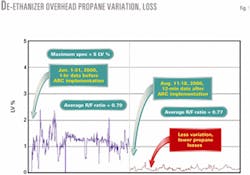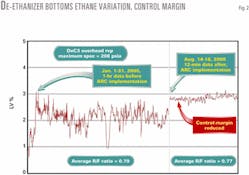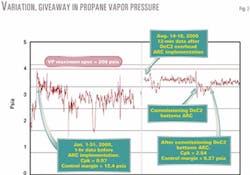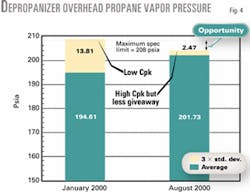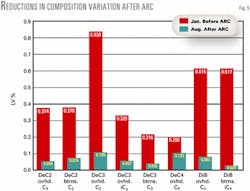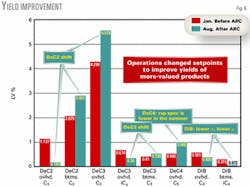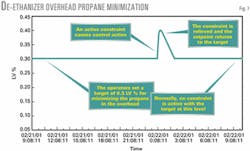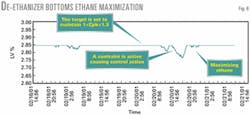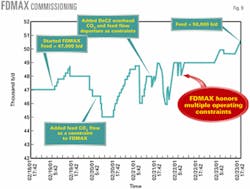A comprehensive package of advanced regulatory control and optimization strategies has been commissioned at Enterprise Products Co.'s Baton Rouge Fractionator in Port Allen, La.
Relying entirely on the distributed control system (DCS) for computing and control functions, these strategies improved process stability and decreased operator workload.
The variability in compositions was also significantly reduced (standard deviation or Sigma reduced by a factor of 3-6), permitting much closer operation to product specifications.
Targeted set points were maximized. This allows increased plant throughput, a yield of higher-valued products, or better energy efficiency, as economics dictate. The reduction in variability alone resulted in an estimated payout of less than 6 months.
Enterprise was convinced that additional benefits were achievable with advanced composition and separations control. A project was commissioned and a team assembled consisting of control specialists from Enterprise and from Barry D. Payne & Associates Inc. The engineered solutions employed included:
•Dynamically compensated, model-based estimates of product compositions using tray temperatures and tower pressures.
•Control of integrated energy and material balance models.
•Strategies to "push" against multiple constraints, maximizing inlet rate, propane rvp, and hot oil system efficiency.
The implementation took place during normal operations, with only a limited amount of testing. Operators said the plant was much easier to run with the improved controls.
The project yielded reductions in the standard deviation of most product compositions by factors of 3-6. The increase in propane yield alone increased product revenues several times the total project cost on an annual basis.
The project's success demonstrates that ARC implemented in the control system is a sustainable technology, requiring less maintenance and ongoing support than other types of enhanced control.
The plant
Enterprise's 60,000-b/d Baton Rouge Fractionator (BRF) came on stream in mid-1999, incorporates a high degree of heat integration, and processes liquids from several major gas plants along the Gulf Coast.
The plant receives most NGL feed from a major pipeline, which is fed by several gas processing plants in Alabama and Louisiana. Some additional feed comes from a refinery.
Although the pipeline is supported by a storage well, it generally only receives excess feed and does not provide significant feed blending. Therefore, the plant is subject to direct-feed composition upsets caused by upstream disturbances.
The de-ethanizer makes maximum use of process heat and is heat integrated with the debutanizer.
A propylene refrigeration system provides overhead condensing on the de-ethanizer.
The depropanizer is fed directly from the de-ethanizer bottoms and utilizes a single reboiler heated by hot oil. Overheads are condensed against cooling water.
Constructed in 1998-99, the plant employs a modern DCS plus an online analyzer system with a Modbus communication interface to the DCS.
The DCS has a powerful process historian utilizing a relational database system. The analyzer and historian systems were essential to completing the project and assessing the results.
Control philosophy
Advanced regulatory control strategies reduce the variations in tower product qualities. They facilitate optimization (or set point management strategies that satisfy operational objectives) and honor operational constraints and product specifications.
A project methodology was followed to ensure that the implemented solution was comprehensive and met all objectives.
Advanced regulatory control
The advanced regulatory control (ARC) distillation strategies minimize the variation in the product qualities (compositions) and enable set point management strategies for optimization. This requires feedforward controls and strategies that minimize control interaction.
Dual composition controllers set the separation capability by adjusting the liquid-to-vapor ratio (L/V) and setting the tower material balance (MB).1
The following control loop pairing is observed because changes to the material-balance split significantly affect the product compositions, and separation capability directly affects tower loading:
•The material-balance split is used to control the more-valued product quality.
•The separation capability is used to control the less-valued product quality.
This ARC arrangement uses set point management to facilitate highly effective optimization strategies.
Optimization via set point management
The optimization philosophy meets optimization objectives by adjusting the ARC product-quality set points.
The set point of the more-valued product is moved to reduce the control margin (improving the yield) while maintaining adequate process capability.2 3
The set point of the less-valued product is decreased toward a minimum, which increases tower loading as separation is increased.
As loading constraints are approached, the less-valued product set point begins increasing (to decrease the loading), but it is constrained by the set point high limit.
Production maximization
Production maximization is a constrained optimization process involving the entire plant.
The goal is to increase production (feed flow rate) while honoring the plant constraints affected by high production levels. The maximizer honors high limits for the set points that set each tower's separation.
Project methodology
The engineer has several key components to consider in planning the project:
- Establish the scope of the control design.
- Identify disturbances.
- Identify tower operational constraints.
- Identify constraints to production maximization.
- Identify operational objectives.
- Design to facilitate optimization.
ARC results
The basic regulatory controllers were retuned to prepare for implementations of advanced process control at the Baton Rouge Fractionator. This retuning resulted in some improvement in operations. All improvements noted here are the result of both retuning basic controllers and the addition of advanced process control.
Comparisons have been made between data taken in January when the BRF was running very well, and August data taken just following the ARC implementation.
During January, de-ethanizer (DEC2) feed flow averaged 61,700 b/d. The weather was cool, providing relief to some operational constraints. During the August data collections, the plant feed averaged 55,500 b/d.
Direct results from the ARC implementation are the reductions in variation of the tower product compositions.
Other results, such as increased yield and reduced product quality giveaway, are due to set-point management facilitated by the ARC implementation.
The following metrics are used when discussing process capability:
- The sample average referred to as the average.
- The sample standard deviation.
- The control margin—the difference between the average and the specification limit.
- The product giveaway—lost profit due to control margin.
- The process capability, Cpk—an index of the capability of honoring a specification limit.4
Cpk = (Max. Spec Limit–Average) / (3*Standard Deviation)
The smaller the Cpk, the more likely the specification will be violated. Variation should be reduced or the control margin should be increased. A Cpk > 1.0 but < 1.3 is the goal for statistically good control.
A Cpk > 1.3 indicates excessive control margin and the need for set-point management.
Table 1 summarizes the ARC structures implemented at the BRF.
DeC2 ARC results
The ARC strategies implemented on the de-ethanizer are overhead L/V ratio strategy and bottoms indirect or internal material-balance split strategy.
The bottoms control uses a dynamically compensated model prediction of ethane based on temperature, pressure, and measured composition.
DeC2 overhead L/V ratio results
Fig. 1 shows the effect of the ARC implementation for the overhead propane composition control. As Fig. 1 shows, the variability of the August data with the ARC control is much less than the January data without ARC. The overhead ARC strategy commissioning was finished Aug. 11.
Since the overhead propane composition is much less in August than in January, it would be expected that the reflux-to-feed ratio (R/F) would be much higher; but it was in fact slightly lower. This is because the average composition of ethane in the bottoms had been increased.
An overhead L/V ratio strategy is a very effective companion strategy to a strategy for adjusting the material-balance split with a bottoms quality controller. This is the preferred structure for maximizing the yield of the bottoms product, which is the case for the de-ethanizer.
DeC2 bottoms material-balance split
The de-ethanizer bottoms ARC strategy adjusts the tower material-balance split to control the ethane in the bottoms stream, while honoring the maximum depropanizer overhead rvp limit of 208 psia.
If feasible, increasing the ethane in the bottoms not only reduces product quality giveaway, it also tends to reduce the propane in the de-ethanizer overhead and reduces the tower loading.
Fig. 2 combines January data before the ARC implementation with August data after the ARC implementation. The data show that the ARC implementation substantially reduced the variability.
The average R/F ratio was less in August (0.77) than in September (0.79). Actually, the R/F ratio increased slightly with the implementation of the de-ethanizer overhead L/V strategy and then decreased again with the implementation of the de-ethanizer bottoms material-balance strategy.
DeC2 ARC vs. C3 vapor pressure
The vapor pressure (208 psia) of the depropanizer (DEC3) overhead product is the product specification that constrains the ethane composition in the de-ethanizer bottoms. Fig. 3 shows the vapor pressure results.
Fig. 4 shows the potential to reduce the giveaway in the propane vapor pressure.
DeC3 ARC results
The ARC strategies implemented on the depropanizer are also an overhead L/V ratio strategy and an indirect or internal material-balance split strategy for the tower bottoms.
The bottoms control uses a dynamically compensated model of the propane based on temperature, pressure, and measured composition.
DeC3 overhead L/V ratio results
The effect of the ARC implementation on the overhead isobutane composition is similar to the reduction in variation and losses shown on the de-ethanizer overhead (Fig. 1).
The responsibility of the ARC implementation is to reduce the variability of the isobutane in the propane.
The data for January showed considerably more variation than the data following the overhead ARC commissioning. There was an evident reduction in the average isobutane composition in the overhead.
DeC3 bottoms material-balance split
The combined data for January and August show that the effect of the ARC implementation of the bottoms propane composition control was similar to the result obtained on the de-ethanizer bottoms composition control (Fig. 2).
ARC results
The immediate results from the implementation of the ARC strategies are seen in the following significant reductions in the variability (standard deviation) of product specification (Fig. 5):
- De-ethanizer overhead propane—reduced to 0.054 LV % from 0.374.
- De-ethanizer bottoms ethane—reduced to 0.074 LV % from 0.376.
- Depropanizer overhead vapor pressure—reduced to 0.9 psia from 4.6 psia.
- Depropanizer overhead isobutane—reduced to 0.057 LV % from 0.329 LV %.
- Depropanizer bottoms propane—reduced to 0.042 LV % from 0.216 LV %.
- Debutanizer bottoms rvp—reduced to 0.19 psia from 0.53 psia.
- Deisobutanizer overhead n-butane—reduced to 0.083 LV % from 0.615 LV %.
- Deisobutanizer bottoms isobutane—reduced to 0.029 LV % from 0.617 LV %.
These reductions in variations facilitated significant reductions in product losses or quality giveaway. The de-ethanizer overhead propane decreased to an average 0.16-0.19 LV % from an average of 1.14 LV %, and the depropanizer rvp increased to about 202 psia from 194 psia with its standard deviation improving to less than 1.0 from 4.6.
Fig. 6 shows these and other benefits are shown in Fig. 6. Note that the lower limit of C5 in the DEC4 overheads is dictated by summer gasoline rvp specifications. January C5 was lower, but August standard deviation was one-half of pre-ARC data for January.
Optimization results
The BRF optimization includes strategies to:
- Minimize the propane in the de-ethanizer overhead.
- Maximize the ethane in the de-ethanizer bottoms.
- Minimize the isobutane in the depropanizer overhead.
- Maximize the propane in the depropanizer bottoms.
- Minimize the gasoline in the debutanizer overhead.
- Minimize the movement in the debutanizer reboiler hot oil.
- Maximize the plant feed flow rate.
The specifications for the ethane product are ethane, 95.0% minimum and propane, 5.0% maximum.
This optimization is one part of the strategy to maximize the yield of the propane product. The set point for the de-ethanizer overhead propane is minimized against the following constraints:
- Target set point for the DEC2 overhead propane.
- High limit on the DEC2 pressure drop.
- High limit on the DEC2 reflux flow.
- High limit on the DEC2 reflux valve position.
- High limit on the DEC2 reboiler hot oil flow.
- High limit on the DEC2 reboiler hot oil valve position.
Fig. 7 shows typical results of this strategy.
The set point for the de-ethanizer bottoms ethane is maximized against the target set point for the DEC2 bottoms ethane and the high limit on the DEC3 overhead ethane.
The high limit on the DEC3 overhead rvp is 208 psia at 100° F.
Fig. 8 shows typical results of this strategy.
The BRF production strategy, or feed maximization strategy, is implemented as a computer program, FDMAX. FDMAX maximizes production by increasing the feed flow set point subject to the following:
- Feed flow target (high limit).
- DEC2 reflux accumulator pressure.
- Refrigeration compressor suction pressure.
- Propane losses in the DEC2 overhead.
- Butane losses in the DEC2 overhead.
- Fuel gas pressure.
- Hot oil heater temperature.
- High limit on the feed CO2 flow.
- Plant feed line PIC output.
- DEC2 overhead CO2 ppm.
- DEC2 bottoms level ERROR.
- Feed flow difference (Fsp-Fpv).
The DEC2 feed flow set point is increased at a constant rate until a constraint limit is approached. As the constraint limit is approached, its controller will determine the movement of the feed flow set point.
At the beginning of the APC project, only two process variables were known to be possible feed maximization constraints. Ten more constraints were discovered during implementation.
To ensure all controllers were working, each of the twelve 12 constraints was forced to be the active constraint by adjusting its limit. Fig. 9 shows the feed flow during the final week of FDMAX implementation. During this week, the amine treater was not working as it should, and carbon dioxide became a problem in the feed and in the de-ethanizer overhead.
The significant contribution of a feed maximization strategy is not to increase the feed set point slowly to a target set point, but to honor multiple operating constraints. This feature of FDMAX was thoroughly exercised thanks to the amine treater.
Acknowledgments
The assistance of Bill Wegner, Ted Porter, and Ken Turner of Enterprise and the operators at BRF is gratefully acknowledged.
References
- Luyben, William L., "Introduction," Practical Distillation Control, William L. Luyben, ed., 5, New York, Van Nostrand Reinhold, New York, 1992.
- Western Electric Co. Inc., "Part C: Essential Elements in a Quality Control Program," Statistical Quality Control Handbook, p. 45, Charlotte NC, Delmar Printing Co., Second Edition, Delmar Printing Co., Charlotte, NC, 1984, p. 45.
- Jessup, P.T., "Continuing Process Control and Process Capability Improvement," Ford Motor Co., Dearborn, Mich., p. 6., 1985, p. 6..
- Jessup, P.T., "Continuing Process Control and Proces Capability Improvement," Ford Motor Co., Dearborn, Mich., 1985, p. 25.
Based on a paper presentationed at to the 81st Annual Gas Processors Association Convention, Dallas, Mar. 11-13, 2002.
The authors
Terry Hurlburt ([email protected]) is vice-president and general manager of operations for Enterprise Products Operating LP, in Houston. He has more than 28 years of experience in operations management and chemical, refinery, and gas processing engineering. Hurlburt holds a BS in chemical engineering from the University of Minnesota, and he is a member of the operations and maintenance, and technical committees of the Gas Processors Association.
Walter Rossow ([email protected]) is a process control engineer for Enterprise Products Operating LP. He joined Enterprise Products in 1980 as an analyzer technician and has worked in various positions at Enterprise's' Mont Belvieu plant, including I&E supervisor and project engineering liaison for new projects. He joined the process control group in 1990 and has studied process control technology at the University of Houston, Clear Lake.
Ron McDaniel ([email protected]) is a principal consulting engineer with Barry D. Payne & Associates Inc. (BDP), Houston. McDaniel retired from the Dow Chemical Co. as a senior process control associate in 1997 after 27 years in the process engineering and control functions. He joined BDP in 1999. McDaniel received a BS (1966), an MS (1968), and a PhD (1970) in chemical engineering from Texas A&M University.
Ray Dollar ([email protected]) is a senior consulting engineer with Barry D. Payne & Associates Inc. (BDP), Houston. Prior to joining BDP in 1997, he spent 25 years with Dow Chemical Co., Freeport, Tex., in process control functions. He received a BS (1965) in chemical engineering from the University of Mississippi and an MS (1967) and PhD (1969) in chemical engineering from Louisiana State University.


